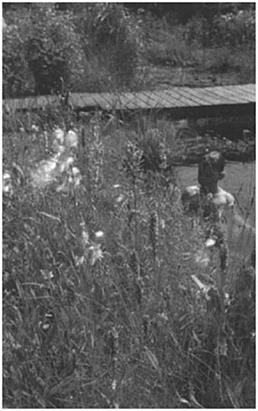Planting substrates
In natural wetlands and water bodies, the existing soil is usually planted without drastic modifications.
|
|
8.26
Along the wetland zone, framing the swimming area of the author’s pond, a fen has been developed with Dactylorhiza (orchids), Eriophorum latifolium and attractive flowering gems between Carex davalliana and ground-cover grasses. Behind the wooden deck the densely planted regeneration-zone
Thus, the range of plants has to be co-ordinated sensitively with the existing trophic level, chemical reaction and soil textural class. To avoid germination of weeds, a 5 cm mulch – layer of bark chips or gravel can be beneficial. On the other hand, planting beds of artificially sealed ponds should be covered with a substrate, chosen according to the intended planting habitat.
In zones 4 and 5 in small water bodies, baskets are sometimes recommended as a way of economising on substrate. Enclosed containers offer the advantage of preventing rhizomes from escaping, but nutrients are quickly used up and demanding species show symptoms of deficiency, especially nitrogen. Therefore, containers should be fertilised with a slow release nitrogen source such as hoof and horn chips (2-3 g/l), and re-potted after dividing the root stock every two to four years. Containers with helophytes emerging high above the water level are easily knocked over by gusts of wind. In large, deep ponds, pre-cast concrete ring-units are preferable as planting beds for water lilies, lifting them up to a suitable depth.
Generally, it is preferable to plant into a substrate layer spread directly over the lining material of the water body. To avoid nutrient accumulation in the water body, nutrient – poor substrate material is recommended. For rooting of helophytes and hydrophytes in zones 3 to 5, it is sufficient to use a 10 cm layer of lime-free pebbles 2-16 mm in size. In the wetland zone (zone 2), more fine-grained material should be used the more the substrate surface is raised above the water level. The following recommendations are valid in ponds as well as in swamp beds and other applications.
Raised-bog plantings can be established in pure Sphagnum peat, thoroughly soaked with water before use. As a substitute, lime-free sand is suitable as a lower layer, covered with only 5 cm peat, coconut-fibre-wool or unfertilised timber-fibre (Toresa). Sphagnum mosses should be pressed on parts of the wet peat-surface to develop a living substrate. Substrate for transition bogs can be composed likewise when supplied with semi-hard water. A very poor and acid water quality can be compensated by a 5-10 cm layer of base-containing gravel (lava, pumice, expanded clay) underneath the peat, or a very thin layer of limestone or dolomitic gravel. For lime-fen vegetation, limestone gravel (2-8 mm) should be used as a substrate, the layer above the water level can be mixed with 50% Sphagnum peat.
The substrate depth for meso-eutrophic to eutrophic tall forb communities should be more than 25 cm. The submerged substrate should be sandy or granular in order to support the influx of water and nutrients, whereas clay or loamy subsoil can become mixed into the layer above the water level. The contained clay-minerals improve the chemical buffering. Topsoil is unsuitable because of its high nutrient content and because of its weed-seed loading. The substrate surface can be covered with gravel as a mulch. Substrate used for transition bogs, fen and meso – to eutrophic tall forb communities can be mixed with 30% shredded bark. Water and swamp plants from eutrophic sites can be supplied with nitrogen by starting fertilisation with horn chips (up to 50 g per plant respectively per m2) mixed into the substrate.




